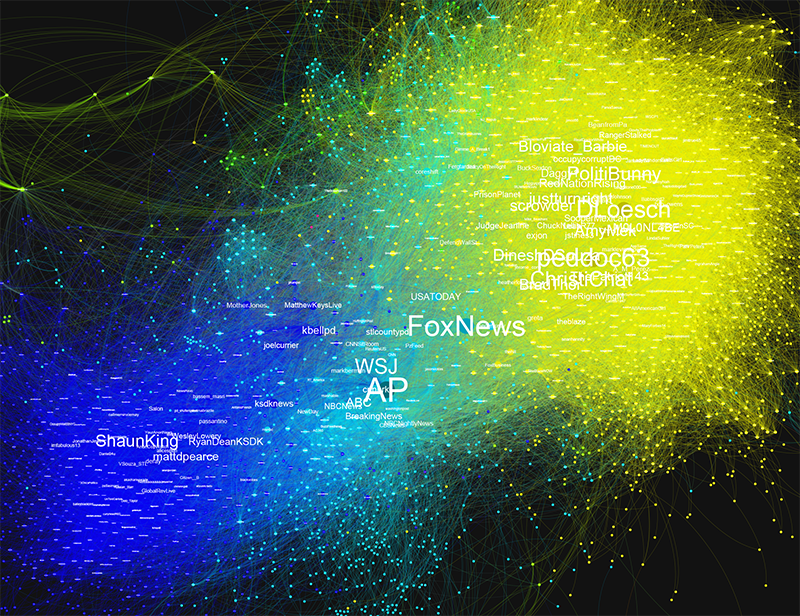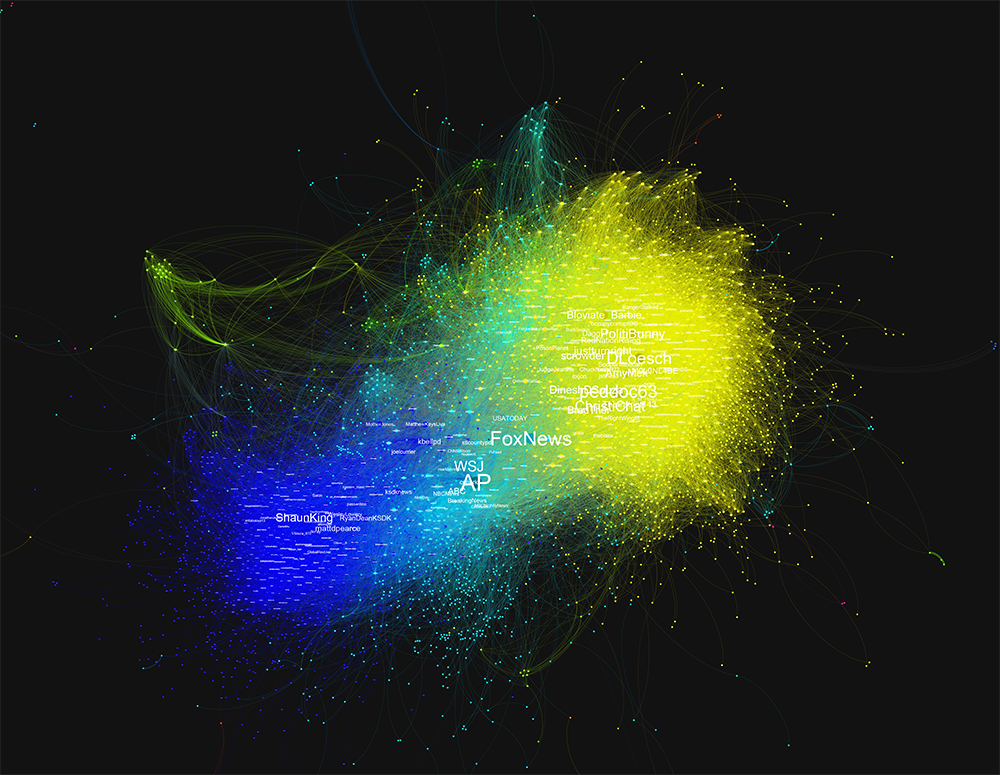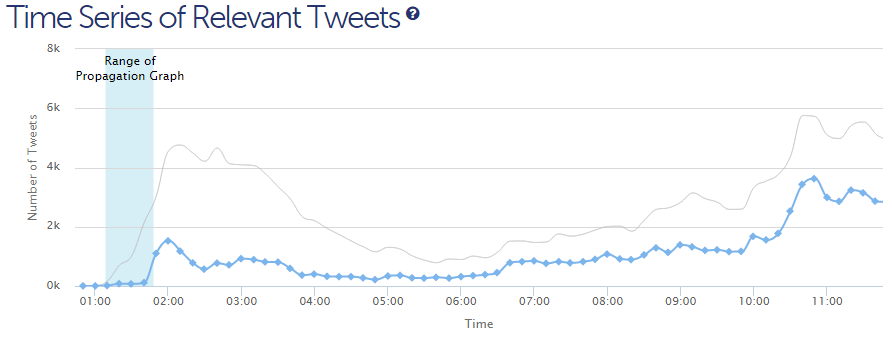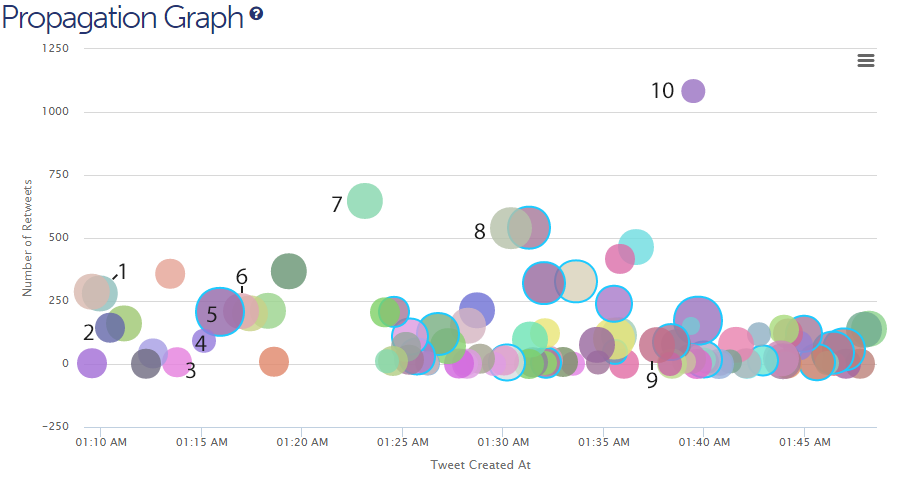The Ferguson police chief resigned on March 11th, 2015, following the Justice Department’s report about systematic bias in the Ferguson police department. This prompted protests outside the police department, during which two police officers were shot and wounded.
Using TwitterTrails, we investigated this claim the following morning, about 10 hours after the shooting, and repeated the data collection twice over the next 12 hours to get a larger dataset. We find that, even though we did not collect data live during the event, TwitterTrails can still reconstruct an interesting and meaningful account of the reporting on Twitter. We capture not only traditional news media reporting, but also first hand accounts written by people on the scene of the protest (which contain information that is less visible in tweets written by the news media). Finally, we find a very polarized audience taking to Twitter to discuss the shooting, as captured by the co-retweeted network.

Read on for our observations, or view the story for yourself on TwitterTrails.
The time series graph shows us the activity of the discussion on Twitter, with two different series: the blue line, which shows the relevant tweets we collected, and the grey line, which is an estimation of total activity based on the number of retweets of original tweets that we collected.
Activity begins to pick up shortly after the shooting shortly after 1am, and reaches an estimated high of around 5,000 tweets in a 10 minute interval around 2 am on March 12th. We will focus on the very beginning of the activity, when the story first broke on Twitter, as captured through the Propagation Graph:
10 tweets have been manually labeled on the graph, and are displayed below (note that on TwitterTrails, you can hover over a point on the graph to see the tweet):
Tweets 1 and 2 are the first to report on the shooting (the handful of tweets before these are commenting on the protest in general), first hand accounts from individuals on the scene (both users have written many tweets during the night, including posting images/videos, so it seems reasonable to assume they were actually there; in addition, @deray is a prominent activist in the Ferguson protests).
Tweets highlighted in blue on the graph come from verified accounts, largely reporting the fact that two officers were shot (tweet #5 is the first of these). There are of course unverified accounts doing similar reporting, as shown in 4.
There are also tweets (6, 7 and 8) reporting a fact that is less visible or not reported in the early official news media posts, that the shots were not fired from the group of protesters, but instead came from a hill. Considering a lot of the backlash against protesters expressed by some users in the hours following the shooting, this fact has some significance (though whether it would have changed their opinions is another question).
Tweets 3, 9 and 10 are some of the early tweets which express the sort of polarizing opinions that we see in the co-retweeted network.
Briefly, the co-retweeted network highlights similarity in users. It is formed by connecting users who have been “co-retweeted,” meaning that the two users have each between retweeted by the same user (if you’re interested in learning more about the co-retweeted network and its applications, check out our paper: The Co-Retweeted Network and its Applications for Measuring the Perceived Political Polarization).
Below is the co-retweeted network for this story.

There are three prominent groups, in yellow, dark blue and light blue. The yellow group consists of mainly conservative users (this fact is often expressed in their Twitter account description), praising police and blaming both protesters and Obama administration (specifically, Eric Holder after the release of the Justice Department report). The dark blue group contains many liberal users, activists and participants in the anti-racism/black lives matter movement. Their tweets contain more of a mix messages: some reporting on the shooting, a range of reactions to police (from anger to irony), and thoughts/prayers toward the injured officers and protesters who were on the scene.
It’s not surprising that these two groups have such a distinct polarization in the network: users who agree with and retweet opinions expressed by one side are very unlikely to agree with and retweet views which are so different from their own.
The accounts in the middle of the graph are largely traditional news media (@AP, @WSJ, @NBC); accounts which conservative or liberal users are equally likely to retweet (with some variation, see @FoxNews pulled near the conservative group).
From the co-retweeted network, we get an interesting overview of the polarizing Twitter discussion about the shooting of the two Ferguson police officers. On the TwitterTrails tool you can click on users in the graph to see all the tweets they wrote or retweeted in the dataset, as well as information about their account (note that the network images in this post are created in Gephi, and the network on the TwitterTrails page appears rotated about 90 degrees compared to these images).
To explore this story yourself, utilize the interactive networks and check out our other visualizations, please visit TwitterTrails.
If you’re interested in working with this network, you can download the .gexf file from our figshare.com repository (and if you’re looking for a way to open this file, try Gephi).


